
Coit Tower is a 210-foot (64 m) tower in the Telegraph Hill neighborhood of San Francisco, California, overlooking the city and San Francisco Bay. The tower, in the city's Pioneer Park, was built between 1932 and 1933 using Lillie Hitchcock Coit's bequest to beautify the city of San Francisco. It was added to the National Register of Historic Places on January 29, 2008.

Donal Hord, an American sculptor, was born Donald Horr in Prentice, Wisconsin.
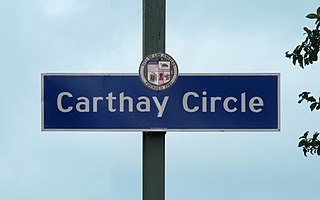
Carthay Circle is a neighborhood in the Mid-City West region of Central Los Angeles, California. Originally named Carthay Center, the neighborhood was later renamed after the famed Carthay Circle Theatre.
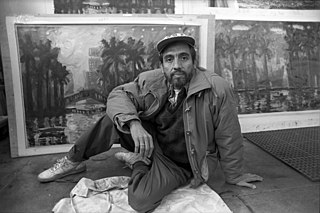
Carlos D. Almaraz was a Mexican-American artist and a pioneer of the Chicano art movement. He was one of the founder of the Centro de Arte Público (1977–1979), a Chicano/Chicana arts organization in Highland Park, Los Angeles.

Dorothy Jeakins was an American costume designer.

Harry Oliver was an American humorist, artist, and Academy Award nominated art director of films from the 1920s and 1930s. Besides his outstanding work in Hollywood, he is now best remembered for his humorous writings about the American Southwest, and his publication (1946–1964) of the Desert Rat Scrap Book, an irregular broadsheet devoted to the Southwest. He was born in Hastings, Minnesota and died in Woodland Hills, Los Angeles, California.
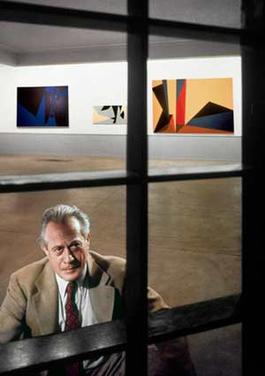
Lorser Feitelson (1898–1978) was an artist known as one of the founding fathers of Southern California–based hard-edge painting. Born in Savannah, Georgia, Feitelson was raised in New York City, where his family relocated shortly after his birth. His rise to prominence occurred after he moved to California in 1927.

The Carthay Circle Theatre was one of the most famous movie palaces of Hollywood's Golden Age. Located on San Vicente Boulevard in Los Angeles, California, it opened in 1926 and was demolished in 1969.
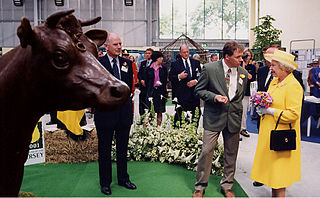
John McKenna is a Scottish sculptor born in Manchester. He is based in Turnberry, South Ayrshire, Scotland.

George Herms is an American artist best known for creating assemblages out of discarded, often rusty, dirty or broken every-day objects, and juxtaposing those objects so as to infuse them with poetry, humor and meaning. He is also known for his works on paper, including works with ink, collage, drawing, paint and poetry. The prolific Herms has also created theater pieces, about which he has said, "I treat it as a Joseph Cornell box big enough that you can walk around in. It's just a continuation of my sculpture, one year at a time." Legendary curator Walter Hopps, who met Herms in 1956, "placed Herms on a dazzling continuum of assemblage artists that includes Pablo Picasso, Kurt Schwitters, Marcel Duchamp, and Joseph Cornell, as well as California luminaries Wallace Berman and Edward Kienholz." Often called a member of the West Coast Beat movement, Herms said that Wallace Berman taught him that "any object, even a mundane cast-off, could be of great interest if contextualized properly." "That’s my whole thing," Herms says. "I turn shit into gold. I just really want to see something I've never seen before." George Herms lives and works in Los Angeles.
Betty Asher was an American art collector and dealer. An ardent supporter of Pop art and Contemporary art, her large collection of cups and saucers by artists was world-famous.
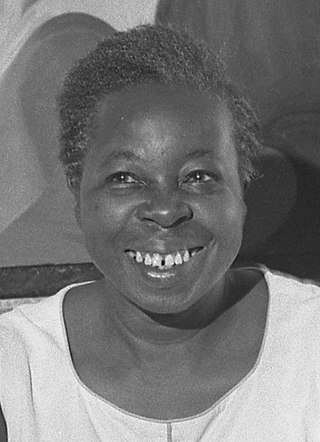
Ruth G. Waddy was an American artist, printmaker, activist, and editor, based in Los Angeles.

Storytellers is a bronze statue depicting Walt Disney standing next to his most famous creation, Mickey Mouse, which serves as a counterpart to the iconic Partners statue at Disneyland. The statue was commissioned for the overhauled and expanded Disney California Adventure theme park in Anaheim, California, where it stands in front of a recreation of the Carthay Circle Theatre on Buena Vista Street. Subsequent recreations of the statue are found at the entrance of Tokyo DisneySea in Tokyo, Japan and at the end of Mickey Avenue at Shanghai Disneyland in Pudong, Shanghai, China.
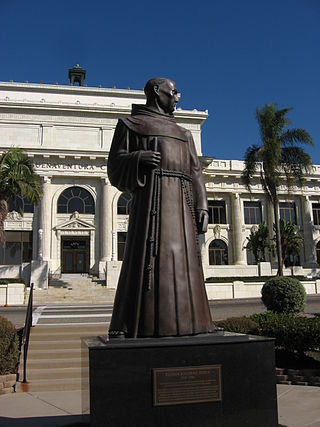
The Father Serra statue at the Mission San Buenaventura in Ventura, California, representing Junípero Serra, the founder of the mission, was commissioned by Ventura County through the Works Progress Administration as part of the Federal Art Project in 1935. This statue, made of concrete from a clay model by Uno John Palo Kangas, was originally placed in 1936 in a prominent location in a public park across the street from the Ventura County Courthouse. After the Courthouse was repurposed as Ventura City Hall, the statue was designated as City of Ventura Historic Landmark No. 3 in 1974. As deterioration of the concrete statue became a concern, a wood replica was created by local carvers and used to make a bronze cast. The concrete statue was replaced by the bronze cast in 1989. The wood replica was set in the atrium of the city hall for public display.

Henry Lion was an American sculptor. His work was part of the sculpture event in the art competition at the 1932 Summer Olympics.
Frank Edward Romero is an American artist considered to be a pioneer in the Chicano art movement. Romero's paintings and mural works explore Chicano and Los Angeles iconography, often featuring palm trees and bright colors.
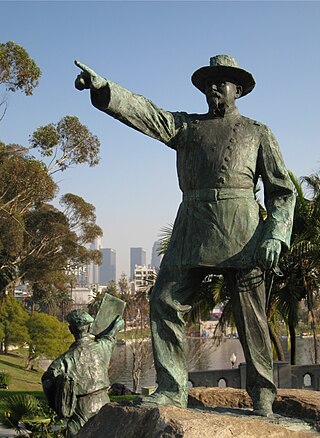
A statue of Harrison Gray Otis is installed in Los Angeles' MacArthur Park, in the U.S. state of California. The bronze statue was originally part of a sculptural group that originally included a newsboy and a soldier. The artist, Paul Troubetzkoy, won a design competition in 1918 and the final product was installed in 1920. The soldier has been absent for decades, the newsboy was stolen for its scrap metal value in March 2024. The theft was discovered by Anne-Lise Desmas, an art historian and Getty Museum curator who brought a colleague from the Louvre to the park to see Troubetzkoy's work and found the newsboy absent. Investigators believe that the metal thieves posed as city maintenance workers to avoid questions about what they were doing with the cast-bronze figure.
Elizabeth Jane Lochrie Hoag McGlynn, most often known as Betty Hoag, was an American art collector, museum director, and art historian who specialized in painters of California and Hawaii, as well as in the New Deal art of the 1930s. In the 1960s she conducted dozens of oral history interviews with New Deal artists for the Smithsonian's Archives of American Art.

James McKay Redmond was an American painter, muralist, and printmaker active in Los Angeles in the 1920s and 1930s. His prismatic colors and sinuous lines were admired by the critics of his day and his New Deal-era murals are considered particularly fine exemplars of the genre. A leader in the local art community, he succeeded his mentor Stanton MacDonald-Wright as a director of the progressive and influential Art Students League of Los Angeles and steered the organization through the Great Depression. During World War II, he enlisted in the U.S. Army, and landed at Omaha Beach in Normandy, France on D-Day with his battalion of combat engineers. Redmond was killed in action four days before Christmas 1944 during the German counteroffensive into the Ardennes Forest known as the Battle of the Bulge.

















